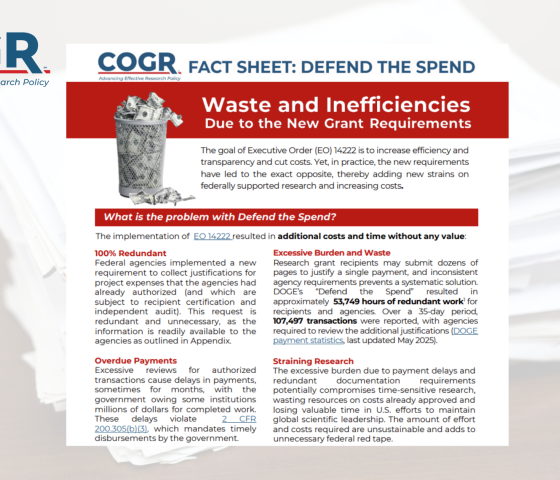Executive Order 14222, intended to enhance efficiency and transparency and reduce costs in federally funded research, has instead imposed significant new...
Other Post Award
Financial research accounting, management, and billing activities are subject to various and evolving requirements. COGR assesses and reports on significant changes, as well as advocating for practical requirements that provide effective safeguards without undue administrative burden.

Featured
Points to Consider for Reimbursement of Expenses Under Active Grants (V.2): Framework for Navigating the 2025 Administration Transition
Changes to federal payment systems, processes, and requirements implementing
Updated: Costing Points to Consider for Terminations and Suspensions (V.2)
Communications from federal agencies about terminations and suspensions are inconsistent with each other and often with sponsor policies and Uniform Guidance.&…
Resources
Point of Contact
All Other Post Award Articles
Appendix 3 to F&A Capstone Report: COGR Member Universities Responding to 2023 Cost Reimbursement Rate Survey
The document presents data from the COGR 2023 F&A (Facilities & Administrative) Survey, focusing on average administrative cost components at member universities, segmented by U.S. region and institutional research expenditures (HERD categories). The reported averages indicate notable variations across regions and institution sizes, with Northeast institutions consistently reporting some o
Cost of Compliance: Results from the COGR Survey on the Cost of Complying with the New NIH DMS Policy
The document summarizes the findings from a 2022 COGR survey assessing the financial and administrative burdens imposed by the new NIH Data Management and Sharing (DMS) Policy, effective January 2023, which expanded data management requirements to all NIH-funded research projects generating scientific data. The survey, completed by 34 institutions (29 mid-size to large and 5 smaller institutions),
Update & Errata to COGR November 2021 Update
The document provides an update and clarification regarding the resolution of an NSF Office of Inspector General (OIG) audit finding related to the application of Facilities & Administrative (F&A) cost rates on NSF awards, as discussed during a recent NIH/NSF panel session. The concern stemmed from situations where an institution proposes an F&A cost rate during the grant application p
The Politics of Indirect Costs
The provided document appears to be a lengthy, multi-part data set composed predominantly of encoded or unintelligible text, intermixed with a few recognizable words, symbols, and irregular sequences, as well as delimiters and what seem to be placeholder characters. The structure suggests that the content may have been either corrupted, encrypted, or intentionally obfuscated, making direct interpr
Associations Oppose Cuts to NIH Budget
COGR joined with over 100 other organizations Monday on
2017 COGR Survey of F&A Rates
The 2017 COGR Survey of Facilities & Administrative (F&A) Rates provides a detailed analysis of trends in research operating costs across U.S. research universities over a ten-year period, from FY2007 to FY2017. The survey, conducted online with input from 145 institutions, captures a representative cross-section of universities under different federal cognizant agencies, including regions
Appendix A: 2017 F&A Survey
Appendix A provides a series of survey screen shots, spanning ten sequential pages. Each page appears to capture visual representations of the user interface presented to survey respondents during the data collection process. The inclusion of these screen shots serves to document the design, structure, and functionality of the survey instrument, ensuring transparency and facilitating replication o
Appendix B Data: 2017 F&A Survey
The Appendix B – Survey Data Sheet details the results of a 2017 survey administered by the Council on Governmental Relations, focusing on institutional practices related to federal rate agreements, clinical trials, and negotiation experiences. Of the 145 institutions responding, 70% were public and 30% private, with a significant majority (89%) designating the Department of Health and Human Servi
Pagination
- 1
- 2



